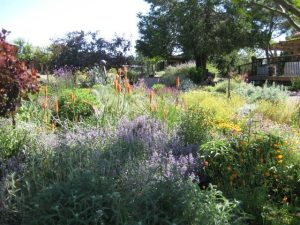Those of us who moved to the Sierra Nevada from the cities and suburbs did so because we loved the smell of the cedars, the vertical grandeur of the granite peaks, the lush, green meadows and the ruggedness of the outdoors. We were looking for a more pristine, natural environment than what the urbs and the burbs could provide. Swimming in a mountain lake with a soft breeze wafting over the surface seemed like a baptism in Nature.
Why, then, bring the aesthetic values of the cities and suburbs up here to the mountains? The city garden, for instance, is a study in constriction and confinement. Square patches of overly-watered lawns, manicured and fertilized until they glow like neon in front and back yards, look so jarringly out of place up here, where the lines of the landscape meander and stretch out for miles. Especially this year, with our alarmingly persistent drought, lawns and English gardens are as thirsty as they are wasteful in a dry California climate with dwindling water resources.
Lawns do almost nothing for the environment, and they use an inordinate amount of water. According to the United States Environmental Protection Agency, “An American family of four can use 400 gallons of water per day, and about 30 percent of that is devoted to outdoor uses. More than half of that outdoor water is used for watering lawns and gardens. Nationwide, landscape irrigation is estimated to account for almost one-third of all residential water use, totaling more than 7 billion gallons per day.”
The fertilizers and herbicides needed to preserve a green lawn are washed by rain and irrigation into the very lakes and streams we came up to enjoy in the mountains, making them unfit for swimming and fishing in many cases. Synthetic fertilizers in streams and lakes create algae blooms that block the sun, causing dead zones beneath them. Fish and frogs are especially susceptible to herbicides and can end up producing deformed offspring.
John Greenlee, in his book, “The American Meadow Garden: Creating A Natural Alternative to the Traditional Lawn,” writes, “Unlike lawns, meadows are better for the environment, a safe habitat for beneficial insects and pollinators, a place where native ecology can thrive. Meadows, by attracting a diversity of ‘life’ are animated, alive with rhythmic movement, catching both wind and light.” He also suggests that the best place to start a meadow garden is where the lawn is.
Another attractive alternative to the lawn is to introduce more hardscape. Paths, waterfalls, ponds, fountains and rock walls fit into the rocky mountain environment and use little to no water. The sound of water in in the garden is pleasing to the senses, while attracting birds and pollinating insects.
Another alternative to the urban garden is a rock garden. This is especially effective when dealing with steep hillsides. By piling rocks into attractive, naturalistic shapes on the side of the mountain, you can put planting soil in spaces between the stones and plant a variety of beautiful, drought tolerant flowers and shrubs.
Planting native flowers and grasses will also cut down on watering and will need no fertilizing. A little composted mulch is all that is needed to make a mountain garden thrive in the hot, arid summer climate of the Sierra Nevada. For a list of plants native to the Sierra foothills, go to California Native Plant Society, for suggested natives to plant in this area.
There are few things more spectacular than a mountain meadow with wild flowers and a mélange of grasses and shrubs. The fragrance of the vegetation and the view of the surrounding mountains is hard to beat. Why not take it home with us? We can plant our own micro-meadow and enjoy the mountain habitat by just looking out our windows.
Francie McGowan is a University of California Cooperative Extension Master Gardener of Tuolumne County who is an anti-lawn convert and is on a mission!
UCCE Master Gardeners of Tuolumne County can answer home gardening questions. Call 209-533-5912 or go to: http://ucanr.edu/survey/survey.cfm?surveynumber=7269 to fill out our easy-to-use problem questionnaire. Check out our website at: http://cecentralsierra.ucanr.edu/Master_Gardeners/ You can also find us on Facebook, or pick up the local Master Gardener book “Sharing the Knowledge: Gardening in the Mother Lode” at Mountain Books or the UCCE Office both in Sonora, CA.


